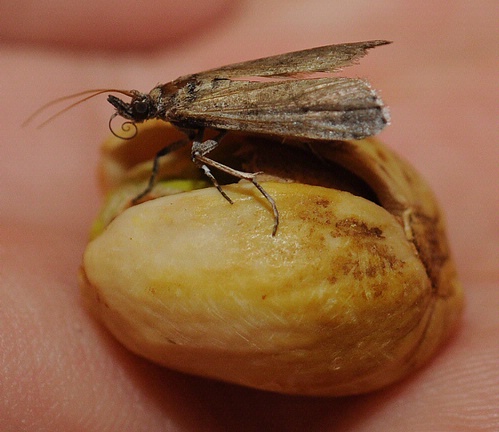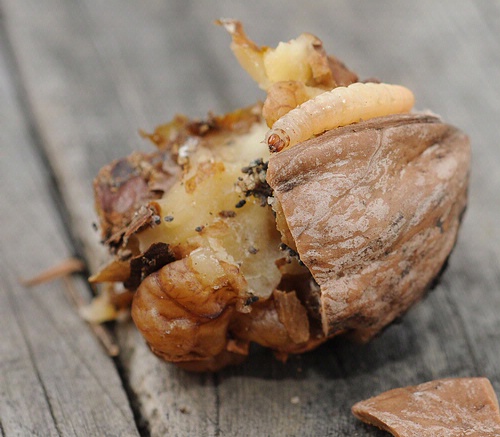
Navel orangeworm
| Primefact number | Edition | Published | Author |
|---|---|---|---|
| 1195 | Second | Apr 2017 | Plant Biosecurity and Product Integrity |


Navel orangeworm (Amyelois transitella) is an exotic plant pest not present in Australia. This pest is a serious threat to Australia’s citrus industry.
Navel orangeworm is a moth (Figure 1).
Larvae feed on a range of fruit and nut crops. In nut crops the yield is reduced by the larvae eating the nuts. In citrus, larvae graze on the fruit causing surface scarring and internal damage.
Notifiable status
Navel orangeworm (Amyelois transitella) is a notifiable plant pest in NSW.
All notifiable plant pests and diseases must be reported within 1 working day. You can report notifiable plant pests and diseases by one of the following methods:
- Call the Exotic Plant Pest Hotline 1800 084 881
- Email biosecurity@dpi.nsw.gov.au with a clear photo and your contact details
- Complete an online form
A full list of notifiable plant pests and diseases can be found in Schedule 2 of the NSW Biosecurity Act 2015.
Signs of infestation
In nut crops such as almond and walnut the larvae produce frass and webbing as they eat the kernel (Figure 2). Damage caused by the larvae increases the chance of infection by aflatoxin producing fungi which further reduces the quality of the nut crop and affects taste and food safety.
Surface scarring and frass are signs of infestation in citrus. Larvae reside in splits and wounds of fruit and feed in or near the core. The quality of fruit is reduced by insect damage and infection by fruit rotting fungi. Increased fruit drop may occur.
Description
Navel orangeworm moths are a greyish-brown colour and are 9–11 mm in length.
The head has a snout-like projection at the front. A distinctive pair of crescent-shaped marks is present on the second segment behind the head.
Larvae are a white to pink colour with a dark reddish-brown head. As in the adult stage, a distinctive pair of crescent-shaped marks is present on the second segment behind the head.
Lifecycle
Navel orangeworm eggs are laid on mummified nuts in trees or in new crop nuts after hull split commences. In citrus eggs are laid at the navel end of damaged fruit. The eggs are small, oval and flattened with ridge-like marks.
Eggs hatch after 4-23 days depending on temperature.
Larvae can overwinter in mummified nuts either in trees or on the ground. Larvae grow 13–19 mm long before pupating in infested fruit or nuts.
Pupae are 7–12 mm long and a dark brown colour.
In the spring adults emerge and begin to lay eggs.
Host range
Navel orangeworm larvae feed on a wide variety of fruit and tree nut crops.
Tree nut crops include almond, pistachio, macadamia and walnut.
Fruit crops include citrus, date, fig, apple, pear and stonefruit.
Distribution
Navel orangeworm occurs in Mexico, the United States and Canada.
Australia is currently free from navel orangeworm.
Spread and movement
Long distance spread occurs by the movement of nuts and plant material infested with larvae or pupae of navel orangeworm.
Actions to minimise risks
Put in place biosecurity best practice actions to prevent entry, establishment and spread of pests and disease:
- practice “Come clean, Go clean”
- ensure all staff and visitors are instructed in and adhere to your business management hygiene requirements
- source propagation material of a known high health status from reputable suppliers
- keep records

